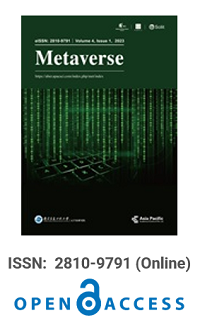|
|
||
About This Journal
Focus and ScopeThe rapid development of science and technology including cloud computing, chips, 5G, and artificial intelligence technology, has stimulated the recovery of the metaverse. From the technical point of view, we (it seems) have touched the threshold of the metaverse, which is no longer as far away as before. The metaverse includes such six technologies as blockchain technology, interactivity technology (VR/AR/MR/XR/ER), game technology (game engine, game code, multimedia resources), AI technology, network communication technology, and Internet of Things. To support the operation of the huge metaverse, it also needs extremely powerful algorithms. The metaverse is a digital universe and a parallel world, which involves the application and development of Metaverse in various fields, including but not limited to: education, art, philosophy, industry, medicine, agriculture, forest. Metaverse (Met) is an open-access academic journal that studies relevant issues on metaverse. Met also welcomes different types of articles including research article, case report, review, perspective, and method concerned with metaverse studies such as the concept definition and its development. The technologies of articles' research in the journal include, but are not limited to:
For Authors
Article Processing Charges (APCs)APASCI’s publishing model is open access. Open access enables readers to freely access and download articles immediately after publication online. APASCI charges authors article processing charges (APCs) so as to cover operation costs, such as those arising from the evaluation and production processes. APCs should be paid upon the acceptance of articles and ahead of publication. APCs of Metaverse are US$800. Waiver and Discount Policy APASCI believes there should be no barriers to the dissemination of knowledge, and thus APASCI offers APC waivers and discounts to authors from low-income countries and authors with special circumstances. Authors should write to the editorial office of the specific journal to apply for waivers and discounts. The decision to approve such applications is made by the editorial office on a case-by-case basis. APC PaymentPayments for APC of this journal can be made through our online PayPal payment gateway. Enter the article no. into the below textbox and select "Pay Now" to proceed with payment. *Article No. is mandatory for payment and it can be found on the acceptance letter issued by the Editorial Office. Payment without indicating Article No. will result in processing problem and delay in article processing. Please note that payments will be processed in USD. You can make payment through Masters, Visa or UnionPay card. |
Academic Support
Institute for Metaverse of Nanjing University of Information Science & Technology (NUIST)
Editor-in-Chief

Director, Institute for Metaverse
Nanjing University of Information Science & Technology
China
Honorary Editor-in-Chief
Academician, Chinese Academy of Engineering
China
ISSN
2810-9791 (Online)
Publishing Frequency
Semi-annual
Manuscript Processing
Initial Decision for Review:
1-3 days after submission
Decision after review:
3 weeks after submission
Online publication time:
2 weeks after acceptance
Indexing & Archiving







Keywords
- VR/AR/MR/XR/ER
- Artificial intelligence
- Smart home technology
- Digital society
- Virtual reality economy
- IoT engineering
- Internet engineering
- Blockchain technology
- Cloud collaboration
- Distributed information technology
- Digital energy
- Digital twin
- Big data
- Human-computer interaction
-
Medical Metaverse
-
Metaverse philosophy
-
Art Metaverse
-
Education Metaverse
-
Industry Metaverse
-
Agriculture & Forest Metaverse
-





